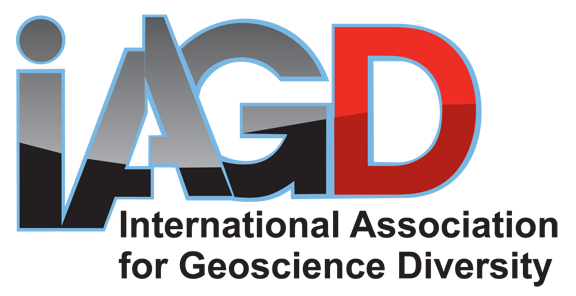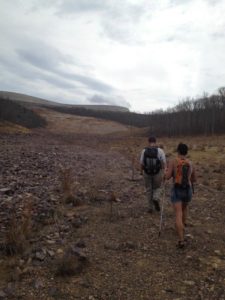A UC researcher leads the trip that ends with participation in the Geological Society of America’s Annual Meeting.
By: Dawn Fuller
Phone: (513) 556-1823
![]()
A group of 15 graduate and undergraduate college students from the U.S. and Canada are packing for an adventure they’ve never had before – a chance to go out in the field on a research expedition that’s fully accessible to students with disabilities.
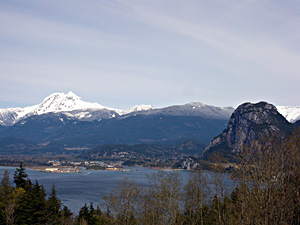
Stawamus Chief Mountain (photo by Brett Gilley)
Fifteen geosciences faculty on the trip will be teaching as well as learning directly from the students about accessibility in the field. The course gets underway in Vancouver, Canada, on Saturday, Oct. 18, and will be led by Christopher Atchison, a University of Cincinnati assistant professor of science education and geology, in coordination with the International Association for Geoscience Diversity (IAGD). Upon completing the noncredit field course, the students will join the Geological Society of America’s Annual Meeting and Exposition in Vancouver from Oct. 19-22. The course is funded by the National Science Foundation and the Society of Exploration Geophysicists, with additional support from the Geological Society of America.
Atchison says it will be the first fully- accessible geology field course offered at the GSA’s annual meeting. Seventeen of the trip’s participants – 13 students and four geoscience faculty members – report having a disability including mobility, cognitive, blind/low-vision, or Deaf /Hard-of-Hearing impairments. The group will be led by Atchison and an international collaboration of geoscience educators and additional student support team members representing the U.S., United Kingdom, New Zealand and Canada.
Included among the faculty participants is Matthew Blackett, an associate professor of physical geography for Coventry University, United Kingdom. “I’m hoping that I can pick up some pointers in terms of accommodating students of all abilities to ensure they do not miss out on the important education and experiences that field trips bring,” says Blackett.
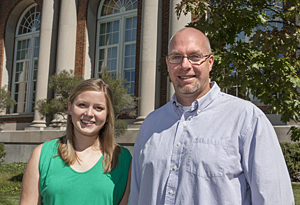
Chris Atchison and his student, Julie Hendricks, working together on expedition of students with disabilities on a geology trip to Vancouver.
Julie Hendricks, a support team member and special education major at UC, will be using her expertise in American Sign Language (ASL) to guide one of the student researchers. “I’ll be working as an interpreter for a student who uses ASL, but I will also be helping Deaf and blind students communicate with each other. Different populations will be using different senses to navigate this experience,” says the UC junior from Batavia, Ohio. Hendricks is also earning a certificate in Deaf Studies at UC.
A total of 35 people will take part in the trip which has two primary functions: to serve as a field-based learning experience for students with disabilities, and to provide professional development for geosciences faculty members interested in creating field courses that offer participation for students with disabilities.
During the Saturday trip, the team will visit six sites in Vancouver that reflect a unique earth science focus. At each stop, students will be encouraged to use all their senses to gain knowledge at each site:
- Stanley Park (Third Beach) – Students will learn about the coastal environment and explore hazards that result from proximity to the ocean.Cypress Mountain
- Lookout – Students will explore how Vancouver’s geological history controls the prevalence of dangerous geologic hazards today.
- Stawamus Chief Mountain – Students will learn how the intersection of igneous intrusions and glacial processes created one of the most iconic mountains in Southwestern British Columbia.
- Garbaldi Park (The Barrier) – Students will learn how the combination of fire and ice (volcanoes and glaciers) tens of thousands of years ago have created a ticking time bomb: one of the largest landslide hazards in the present day.
- Tantalas Range Lookout – Students will gain knowledge about how the erosive power of glaciers can create beautiful mountain ranges.
- Porteau Cove – Students will discover how the fiords are carved by the glaciers and discuss efforts to protect populations from landslides that result from these features.
Sumant Jha, a geophysics doctoral student joining the trip from Colorado State University, reports that as a hard-of-hearing student, this is the first time he has come across an accessible field course in the U.S. and that no such course existed in his home country of India. “I understand that accommodating people with different abilities in such courses is a challenging task. Even in my current doctoral research, I have come across people who could not figure out ‘what is wrong with me,’ and take my lack of response as ‘not knowing.’”
“With this course, I hope to not only learn about the geosciences concept, but also more importantly, how to convey those concepts in a more accessible manner,” says Jha.
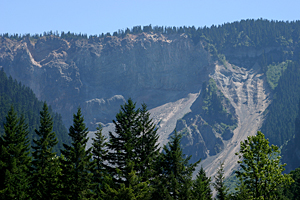
Garbaldi Park (The Barrier). (Photo by Cindy Hansen)
Once it’s time for the GSA Meeting, students and faculty will report on the experience. “However, the outcomes of this workshop will provide more than just a single learning experience; they will potentially become a catalyst to change the way in which current geoscience programs are promoted and offered,” says Atchison.
Atchison says his drive to make field research accessible for all students first started when he was a doctoral student, working on a virtual reality project involving Mammoth Cave National Park with a group of students with disabilities. “I was floored at how excited they were to do something that had never been done before, and how interested they were in the physical environment,” says Atchison. “It changed my entire view toward teaching the geosciences.”
That dedication led to the creation of the International Association for Geoscience Diversity (IAGD). Atchison serves as executive director of the organization dedicated to promoting access, accommodation and inclusion for students and geoscientists with disabilities. Membership has spread out to more than a dozen countries.
The Geological Society of America’s On to the Future Program is funding the registration for the student participants on this trip who are first-time attendees to the meeting. In addition, the GSA is supporting those students’ one-year membership to the organization.
Atchison is a UC science education faculty member in the College of Education, Human Services, and Criminal Justice’s (CECH) FUSION Center, which is dedicated to the advancement of meaningful STEM (science, technology, engineering, mathematics and medicine) literacy for all learners.
UC’s College of Education, Criminal Justice, and Human Services (CECH) has been dedicated to excellence in teaching for more than a century. In addition to preparing students to work in diverse communities, the college provides continual professional development and fosters education leadership at the local, state, national and international levels.
UC’s nationally ranked Department of Geology conducts field research around the world in areas spanning paleontology, quaternary geology, geomorphology, sedimentology, stratigraphy, tectonics, environmental geology and biogeochemistry. The GSA meeting will feature highlights of UC’s geological research that is taking place around the world.
The Geological Society of America, founded in 1888, is a scientific society with more than 26,500 members from academia, government, and industry in more than 100 countries. The GSA Meeting draws geoscientists from around the world representing more than 40 different disciplines.
